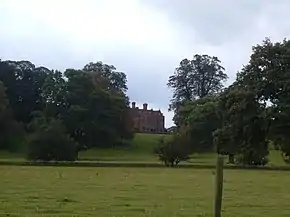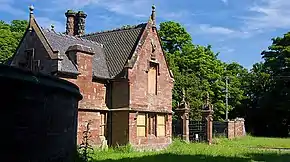

Aqualate Hall, a 20th-century country house, is located in Forton, Staffordshire, England, some 2 miles (3.2 km) east of the market town of Newport, Shropshire and 10 miles (16 km) west of the county town of Stafford. It is a Grade II* listed building.[1]
History
The site of the house may have been occupied in Roman times as two food vessels were found during drainage of the grounds.[2]
The first manor house on the site, built above the Aqualate Mere in the 16th century by Thomas Skrymsher[1] was rebuilt for Edwin Skrymsher (Member of Parliament for Stafford) in the 17th century[1] just after he had completed nearby Forton Hall. The original building remained in much the same style until, Sir John Boughey bought the house in the late 18th century and in 1808 commissioned John Nash to rebuild it in the Gothic style.[3][4] Sir Thomas Boughey developed the house, grounds and associated village in the 1830s.[5]
The building was destroyed by fire on 28 November 1910.[6] The present house, which incorporates some elements of the 17th-century house and of Nash's Gothic successor, was built between 1927 and 1930 by W. D. Caröe. An original range of gables by Nash joins the new house to an 18th-century stable block.[7]
During World War II the house was used an evacuation home.[8] The grounds were used as a military transport base run by the Auxiliary Territorial Service. The Nissen huts which they left behind were then used by the homeless until 1952.[9]
Etymology
The name Aqualate is from Anglo-Saxon Āc-gelād, possibly in the sense "difficult passage over wet ground by the oak trees"; there is much wet and boggy ground in the area and a mere, although Eilert Ekwall suggests Old English Āc-gelãd meaning "oak stream".[10]
Architecture
The square red brick building has clay tile roofs. It has a service wing on the east side.[1] The north front has a two-storey polygonal porch, two projecting canted bays and is decorated with armorial shields and a carved head which used to be on a gatepost.[1] In the grounds can be found stables, two Gothic lodge-houses, and a red brick house with an attached castellated tower.[11][12][13][14]
There is now no sign of the original formal gardens but the boundary of the deer park can still be identified.[15] [16] This contains plantations of oak trees.[17]
See also
References
- 1 2 3 4 5 "Name: AQUALATE HALL List entry Number: 1259928". Historic England. Archived from the original on 10 November 2019. Retrieved 21 March 2020.
- ↑ Chittu, Lily (1929). "Twin Food-vessels preserved at Aqualate Hall, Staffordshire". The Antiquaries Journal. 9 (2): 137–140. doi:10.1017/S0003581500050794. S2CID 162223055. Archived from the original on 18 March 2020. Retrieved 21 March 2020.
- ↑ "Aqualate Hall fire which broke out on 28 November 1910". Discovering Shropshire's History. Retrieved 21 March 2020.
- ↑ Kingsley, Nicholas. "Aqualate Hall". Thread Reader. Retrieved 21 March 2020.
- ↑ "Forton and Meretown Conservation Area Appraisal" (PDF). Stafford Borough Council. Retrieved 21 March 2020.
- ↑ "Aqualate Hall". Lost Heritage. Archived from the original on 19 September 2019. Retrieved 21 March 2020.
- ↑ "Aqualate Hall". Staffordshire Past Track. Retrieved 21 March 2020.
- ↑ "Aqualate Hall". Children's Homes. Retrieved 21 March 2020.
- ↑ Neal, Toby (3 November 2017). "Military invasion which left estate in a state". Shropshire Star. Retrieved 21 March 2020.
- ↑ Ekwall, Eilert (1960). The Concise Oxford Dictionary of English Place Names. Oxford University Press. p. 11. ISBN 978-0-19-869103-7.
- ↑ "Stabling at Aqualate". National Heritage List for England. Historic England. Archived from the original on 11 November 2019. Retrieved 21 March 2020.
- ↑ "Aqualate Castle". National Heritage List for England. Historic England. Archived from the original on 11 November 2019. Retrieved 21 March 2020.
- ↑ "Root Store, Aqualate Hall". National Heritage List for England. Historic England. Archived from the original on 11 November 2019. Retrieved 21 March 2020.
- ↑ "Cow House, Aqualate Hall". National Heritage List for England. Historic England. Archived from the original on 11 November 2019. Retrieved 21 March 2020.
- ↑ "English Nature page on Aqualate Mere". Archived from the original on 25 May 2011. Retrieved 8 March 2009.
- ↑ "Aqualate Hall". Parks and Gardens. Archived from the original on 3 March 2020. Retrieved 21 March 2020.
- ↑ "The Boughey Family". Sit Thomas Boughey Academy. Retrieved 21 March 2020.